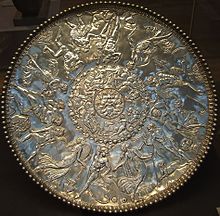Mildenhall Treasure
| Mildenhall Treasure | |
|---|---|
 Mildenhall Treasure in the British Museum | |
| Material | Silver |
| Created | 4th century AD |
| Discovered | 1942 |
| Present location | British Museum |
Mildenhall Treasure is a major hoard of 34 Roman silver objects found in the Mildenhall area of the English county of Suffolk. The hoard was discovered in January 1942 by a Suffolk ploughman, Gordon Butcher, who removed it from the ground with help from Sydney Ford. They did not recognise the objects for what they were, and it was some years before the hoard came to the attention of the authorities. In 1946 the discovery was made public and the treasure was acquired by the British Museum in London.
History
The treasure is believed to have been buried in the 4th century.[1] It includes some of the finest surviving examples of Roman silversmithing, including the mid-4th century Great Dish which measures 605 mm in diameter and weighs 8256 g. The dish glorifies Bacchus and is decorated with a wide band showing a Bacchic revel, at the heart of which is a drinking contest between Bacchus and Hercules, who is shown dead drunk and having to be supported. An inner band of nereids surrounds a foliated head of the sea god, Oceanus.

The dish was discovered with similarly decorated banqueting items: a large flat nielloed dish with geometric decoration, silver platters featuring Pan and maenads, a covered bowl with a frieze of centaurs and wild animals, as well as flanged bowls, ladles and spoons. Although the vast majority of the decoration is classical, three spoons bear the Chi-Rho symbol of Christ, and the Alpha & Omega, a bibical reference to Christ as "the beginning and end". The treasure is thought to be of Mediterranean origin.[2]
Roald Dahl wrote a short story about the find which was published first in the Saturday Evening Post,[3] and later as "The Mildenhall Treasure" in his short story collection The Wonderful Story of Henry Sugar and Six More.[4] In Dahl's story, Ford was fully aware of the significance of the find, but could not bear to part with the treasure. He kept it and restored it in secret, but a piece left out was seen by an unexpected visitor. As a result, Butcher was deprived of a large government reward due to finders of buried gold or silver.
The hoard was number 7 in the list of British archaeological finds selected by experts at the British Museum for the 2003 BBC Television documentary Our Top Ten Treasures presented by Adam Hart-Davis.
See also
References
- ^ "The Mildenhall Treasure". Mildenhall Museum. Retrieved May 4, 2006.
- ^ "The Great Dish from the Mildenhall treasure". The British Museum. Retrieved May 4, 2006.
- ^ Dahl, Roald (1947). "The Mildenhall Treasure" in Saturday Evening Post (20 September): 20-21, 93-4, 96-7, 99.
- ^ Dahl, Roald (1995). The Wonderful Story of Henry Sugar and Six More (5th edition ed.). London: Penguin Group. p. 215. ISBN 0-14-037348-9.
{{cite book}}:|edition=has extra text (help)
